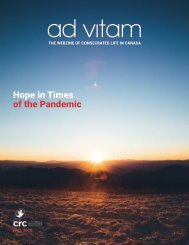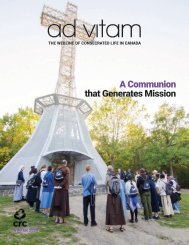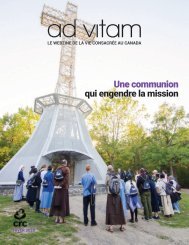ad vitam - Fall 2019
READING TIPS The ad vitam webzine is unique in its offer of an integral and interactive experience featuring articles and audio-visual content. We strongly suggest that you read it online, ideally on a computer or tablet (not recommended on a smartphone). To zoom in: on a computer, double-click or use the + and - found at the bottom-right of the screen; on a tablet, double-tap the screen. Use your mouse or finger to move throughout the page. It is possible to download a PDF of the webzine, however the file will not support links and audio-visual content. For environmental reasons, we invite you to limit printing of the PDF. You may contact us if you wish to obtain a text-only version of a specific article. We hope that as you acquaint yourself with our webzine over time, you’ll enjoy the enriching experience of its unique format. We welcome your comments and questions at info@crc-canada.org.
READING TIPS
The ad vitam webzine is unique in its offer of an integral and interactive experience featuring articles and audio-visual content. We strongly suggest that you read it online, ideally on a computer or tablet (not recommended on a smartphone). To zoom in: on a computer, double-click or use the + and - found at the bottom-right of the screen; on a tablet, double-tap the screen. Use your mouse or finger to move throughout the page.
It is possible to download a PDF of the webzine, however the file will not support links and audio-visual content. For environmental reasons, we invite you to limit printing of the PDF. You may contact us if you wish to obtain a text-only version of a specific article. We hope that as you acquaint yourself with our webzine over time, you’ll enjoy the enriching experience of its unique format. We welcome your comments and questions at info@crc-canada.org.
Create successful ePaper yourself
Turn your PDF publications into a flip-book with our unique Google optimized e-Paper software.
P ERSPECTIVES<br />
Finally, while restorative justice is often associated<br />
with the notion of forgiveness, that is<br />
not the goal of the approach. For some people<br />
who have been victims, the idea of forgiveness<br />
is experienced as a pressure or even a need<br />
of the offender who would like to appease his<br />
conscience. For others, forgiveness will be experienced<br />
as a very personal gesture that is<br />
intended primarily to liberate oneself.<br />
Restorative justice is not opposed to tr<strong>ad</strong>itional<br />
justice: rather, it is complementary to it. Restorative<br />
justice gives the person the freedom to<br />
change and heal internally. It is not a question<br />
of denying or trivializing reprehensible acts,<br />
but of going beyond punishment alone.<br />
Restorative justice in the Church?<br />
In the face of sexual abuse, the Catholic<br />
Church has set up abuse-prevention policies<br />
and pastoral ministries responsible for establishing<br />
safe pastoral environments. Working on<br />
prevention means showing victims that we are<br />
aware of the impact of the acts that have been<br />
inflicted on them.<br />
However, what about repair in the Church?<br />
Assaults have alre<strong>ad</strong>y taken place: lives have<br />
been turned upside down, the social fabric<br />
of many communities of faith has been severely<br />
weakened, offenders have been tried.<br />
Those are the three key elements of restorative<br />
justice: it includes victims, offenders and<br />
the community, and it proposes a process in<br />
which everyone will find some appeasement.<br />
Among the possible ways of repairs in the<br />
Church, here are two of them:<br />
1. Restorative circles<br />
This initiative has been observed in particular<br />
in France and the United States. On November<br />
3, 2018, in Lourdes, during the plenary assembly<br />
of the Bishops of France, the Bishops met<br />
victims of sexual abuses committed by the<br />
clergy. In four different sessions, four circles<br />
of bishops listened to victims testify about<br />
their experiences and suggest ways of prevention<br />
and healing. The meeting’s format did<br />
not inspire unanimity, neither from the victims<br />
nor from the bishops, but the moment will<br />
have been important for having listened to the<br />
words of the survivors of such tragedies. “I felt<br />
to a certain extent reintegrated into the body of<br />
the Church from which I h<strong>ad</strong> felt rejected,” said<br />
Véronique Garnier, abused by a priest for two<br />
years in early <strong>ad</strong>olescence.<br />
In the United States, on May 1, <strong>2019</strong>, a similar<br />
meeting was held at Catholic University of<br />
America. For a whole day, there were discussions<br />
among victims, a dozen bishops, canon<br />
law experts, youth protection specialists and<br />
victim assistance coordinators.<br />
Would it not be possible to organize such<br />
“talking circles,” providing anonymity and<br />
confidentiality, in dioceses or with religious<br />
congregations? These circles could include<br />
survivors, members of the clergy, persons of<br />
consecrated life, as well as representatives<br />
of the community, both civil and church. It<br />
would even be possible to include carefully<br />
selected offenders. The challenge is great<br />
but here is a restorative track to explore.<br />
2. Masses of Reparation<br />
This line of action is more in line with the symbolic<br />
and restorative impact of rituals. Normally,<br />
a Mass of Reparation is held when a serious<br />
act has been committed in a sacred place. In<br />
<strong>2019</strong>, the Archdiocese of Hartford (Connecticut,<br />
USA) held Masses of Reparation, including<br />
in one parish in particular where five aggressor<br />
priests (out of 48 identified by the diocese)<br />
h<strong>ad</strong> been abusive. The archbishop appeared<br />
before the assembly, on his knees, then prostrated<br />
himself and asked forgiveness from<br />
14 • AD VITAM • FALL <strong>2019</strong>










